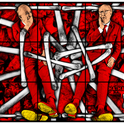The “dress diary” of this book’s title is a bulging album of 2,134 small swatches of fabric: a compilation of snippets, fragments and pieces. Until Kate Strasdin got to work, it was merely a junk-shop curiosity, its creator long forgotten. The album was found in a Camden bric-a-brac stall in the 1960s and handed to Strasdin by a fellow student in a lacemaking class. These random stops in its afterlife are a pleasing reflection of its physical nature.
Each of the swatches has a handwritten caption featuring a name, and sometimes a date or an occasion. The album appeared to be a collection, added to for more than 30 years, of one woman’s wardrobe and those of her friends; a chronicle of mid-Victorian fashions in bits of textiles. But the identity of its creator was only revealed by Strasdin’s transcription of the caption attached to a slip of white muslin: “This is the dress my charming Anne was married in,” signed Adam Sykes. The book’s creator was a woman named Anne Sykes.
From then on, we follow Strasdin through the swatches, each chapter headed by one of the women mentioned. Most are elusive, shreds of lives, some more so than others—and Anne herself is obdurately hard to piece together. A dive into parish records revealed that she was the daughter of James Burton, a prosperous cotton mill owner in Preston, Lancashire, and that her husband, Adam, was the son of a prominent textile designer and manufacturer. They were children of the northern Industrial Revolution—beneficiaries of the grinding labour of the British mills that imported 90 per cent of the cotton grown by enslaved labour in North America and made with it just under half of the world’s cotton.
Fashion often charts the battle between the handmade and artisanal and the industrial and mass-produced; how value was accorded to old skills just as those skills were vanishing under machine-made replicas produced at volume. The 19th century was the age of real silk but also, latterly, of new artificial silk; of chemical dyes that made affordable the colour traditionally produced, in the case of Tyrian purple, by the labour-intensive processing of murex snails. Strasdin shows us the dangers that underlay this colourful world: women and children who made flowers to adorn hats and dresses often died from the arsenic in green and magenta dyes; a fashion for brightly coloured men’s socks resulted in legs covered by welts and lesions.
By the 1830s, new technologies had plunged skilled lacemakers into destitution; it was Queen Victoria’s handmade Honiton lace wedding veil that encouraged the preservation of traditional lace work. Tailoring guilds fought off the encroachment of ready-to-wear black frock coats for the new office workers. But although the album is full of lace, ribbons or edging for collars and cuffs, the battle of skilled fingers against the forces of industry was already lost.
Women and children who made flowers to adorn hats and dresses often died from the arsenic in green and magenta dyes
Clothing, for the middle- and upper-class Victorian, was encoded with the elaborate language of etiquette. Wardrobes bulged with outfits for every occasion. Costume was used to signify barriers between work and home, formal and informal, inside and outside, them and us. The fashion for wearing black when in mourning expanded during this period simply because factories had plenty of clever ways of producing and then selling black with all the trimmings. Strasdin quotes the campaigning journalist Henry Mayhew in 1865: ‘‘In the present day our ashes must be properly selected, our garments must be rent to pattern, our sack cloth must be of the finest quality and that our grief goes for nothing if not fashionable.”
The home was the last haven to industrialise. Though grander houses had steam laundries by the mid-century, laundering remained mostly the day-long work of pre-washing, boiling and scrubbing. Strasdin revels in the ingenuities of domestic labour: she looks at laundering itself, and then at goffering (winding ribbons round hot irons), starching and bleaching, at rubbing stains with potatoes and borax. She notes how the increasing cheapness of factory-spun linen made it easier to have more than one set of underclothes; a weekly wash became associated with poverty.
In 1840, the Sykeses went to Singapore, where Adam had taken up a job with a prominent firm of merchants. Anne wore a sprigged floral cotton when she disembarked. Mr Sykes pops up frequently in the annals of the colony, a member of the committee of the Singapore Chamber of Commerce and the builder of two substantial houses called Bonnygrass and Annanbank. His colleagues’ waistcoats tell a story of prosperity and colonial confidence. For Mr Wise, a white cotton with blue floral repeat; a brown, black and cream silk plush for Mr Connolly; and a multicoloured wool tartan for Mr Duff. Miss Brennand’s smallwares shop was the destination in Singapore for ribbons and trimmings, and Strasdin finds reference to her arrival with her brother 20 years earlier.
Unlike her husband, Anne is invisible in the public records. Strasdin has to piece together a partial life from parts of her friends’ lives. Miss Grant, (three bits of ribbed cottons, patterned), was a representative of the Society for the Promotion of Education in China, India and the East. Mrs Behn, who arrived in Singapore in 1844 from Hamburg, loved colour, as her swatches of printed cotton and hand-embroidered silk testify. Miss Connolly arrived a year later in a shining green taffeta. And Mrs Martin embarked for home in a cream wool with a floral repeat.
Fanny Taylor features prominently. We know that she arrived in Singapore in pink silk decorated with magenta flowers in 1842 and Anne met her in a light white cotton with a stylised blue leaf pattern. Was this meeting their first? Over the next few years, they seemed to have often worn clothes made of identical fabric. This leads Strasdin to a discussion of the 19th-century taste for what scholar Anna Kirk calls “like-dressing”, by which friendship, as well as kinship, was conveyed through matching clothes.
We know little about Hannah Wrigley, but she wore a sharp green taffeta to a costume ball where she dressed as coquettish Dolly Varden from Charles Dickens’s novel Barnaby Rudge. The character of Dolly gave her name to this style of dress (overskirt saucily pulled up to show the underskirt beneath), its Kate Greenaway girliness the look of a thousand Victorian illustrations.
In the absence of Anne, Strasdin was fortunate to have rich historical pickings from the Bostonian Maria Balestier, daughter of US revolutionary hero Paul Revere, who leaves 16 swatches in the album. Balestier’s letters and diaries tell of the boredom of colonial life. “There is nothing here that a lady can do for a living,” she wrote. “Her needle is of small use where labour is so cheap and men do all that kind of work.” Her only child died of a fever in 1844 and she never wore colour again.
What will scraps of fleece, denim and Lycra tell future historians about the economic and political landscapes of the 21st century?
And then there is the fragment of moth-eaten, rough, red fabric marked “pirate flag” and given to Anne by “the admiral”. Could this be a piece of the red standard that, when raised by pirates, indicated “no quarter given”? Strasdin surmises that the admiral was Thomas Cochrane, who at the time commanded a fleet of Royal Navy vessels engaged in anti-piracy in East Asia. According to a contemporary Singapore newspaper, he was “a regular old buck who looked as if he kept himself in a band box”—and from that we learn that the huge expense of naval officers’ finery, all the exquisite gold lace and epaulettes enjoyed by the admiral, was contentious back home. Did Cochrane give bits of pirate flag to all the ladies? The historian cannot always go there, but this book might whet the appetite of a novelist.
The Dress Diary of Anne Sykes is an evocative and often touching exercise in re-imagining these fragments of fabric into historical life. It makes one wonder what scraps of fleece, denim and Lycra will tell future historians of the economic and political landscapes of the 21st century. Strasdin is not always clear; it is often hard to keep track of the confusing chronology; and she can be repetitive and prolix (“pioneers in a harsh landscape that had built a veneer of European comforts, but harboured a maelstrom of challenges beneath”). But this is a book of glimpses caught, of curtains opened on the historical past for an illuminating moment—and it is delightful.














